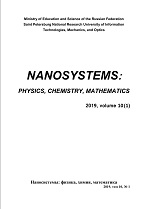|
This article is cited in 1 scientific paper (total in 1 paper)
Optically tuned poly (3-hexylthiophene-2,5-diyl) P3HT/PCBM (modified fullerene) blend for plastic solar cell
Ishwar Naika, Rajashekhar Bhajantrib, Lohit Naikb, B. S. Patilc, Sunil Rathodd, Jagadeesh Naikd, Ullas shetti Pragasama
a Govt. Arts and Science College, Karwar, India
b Dept. of Physics, Karnatak University, Dharwad, India
c Govt. First Grade College Poojgeri, Ankola, India
d Dept. of Physics, Mangalore University, Mangalore, India
Abstract:
Nanotechnology-assisted organic electronics is a wide-spread and promising research field at present in the search for an efficient solar cell. The strong absorption spectra of the donor polymer poly[3-hexylthiophene-2,5-diyl)(P3HT) in the visible region and the prominent absorption of the acceptor [6,6]-phenyl C$_{61}$ butyric acid methyl ester(PCBM) in UV region have proved them to be the most popular donor-acceptor pair for preparing photoactive materials. The active blend, having a broad absorption spectrum, is the primary requisite for an efficient solar cell. The present work is focused on optimizing the photoactive blend of (P3HT)) and PCBM for the maximum absorption of the solar energy. P3HT: PCBM blends of weight ratio 3:1, 1:1 & 1:3 were prepared in xylene as the solvent and glass coated samples are prepared by solution cast method. Samples were characterized by JASCO UV Vis NIR V 670 spectrometer. P3HT has strong absorption in the visible region, while PCBM has an effective absorption in the UV region with broad tail of absorption extending up to 800 nm. The spectrum for the blend is a superposition of the spectra of the component moieties. The 1:3 blend of P3HT with PCBM has broad spectral sensitivity for absorption and can be used as the best photoactive blend for construction of a plastic solar cell. The energy difference (band gap) between Highest Occupied Molecular Orbital (HOMO) and the Lowest Unoccupied Molecular Orbital (LUMO) of the samples were determined through Tauc's plot. Calculations from Tauc's plot indicated that pure P3HT sample has an onset wavelength of 640 nm with a band gap of 1.93 eV. The onset wavelengths for 3:1 & 1:1 blends are almost same of about 632 nm with a band gap of 1.96 eV. The optimized blend 1:3 sample has the onset wavelength 653 nm with the least energy gap 1.9 eV.The absorption by the blend can be further enhanced by either dye sensitization or plasmon resonance.
Keywords:
P3HT, PCBM, HOMO, LUMO, LSPR.
Received: 05.02.2016
Citation:
Ishwar Naik, Rajashekhar Bhajantri, Lohit Naik, B. S. Patil, Sunil Rathod, Jagadeesh Naik, Ullas shetti Pragasam, “Optically tuned poly (3-hexylthiophene-2,5-diyl) P3HT/PCBM (modified fullerene) blend for plastic solar cell”, Nanosystems: Physics, Chemistry, Mathematics, 7:4 (2016), 691–694
Linking options:
https://www.mathnet.ru/eng/nano267 https://www.mathnet.ru/eng/nano/v7/i4/p691
|

| Statistics & downloads: |
| Abstract page: | 56 | | Full-text PDF : | 30 |
|




 Contact us:
Contact us: Terms of Use
Terms of Use
 Registration to the website
Registration to the website Logotypes
Logotypes








 Citation in format
Citation in format 
